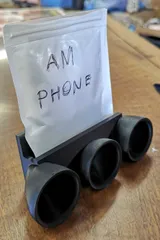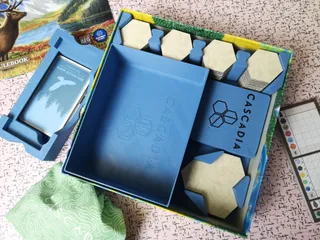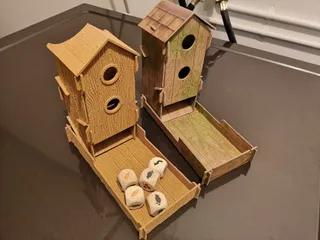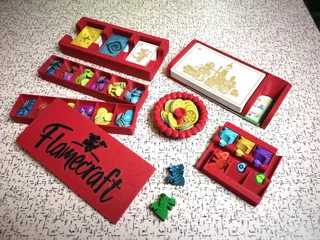Disc Golf glow disc UV auto-charger for nighttime rounds
Description
PDFAdd this sleeve to your bag for fast-charging glow discs for nighttime disc golf!
The LEDs will automatically switch on when the disc is inserted, and automatically switch back off when removed!
In action:
https://imgur.com/a/RKgI1TQ
And a throw:
https://imgur.com/a/E5Yhxyi
This 2-piece print creates a small sleeve which houses the electronics safely out of the way, and includes grooves for the LEDs.
It should fit well enough in most bags since it isn't much larger than a disc (fits fine in my MVP voyager lite anyway).
The only piece which is not housed by the plastic is the USB power supply (battery), since I didn't want to constrain the selection of that (and most people have a few lying around already). The USB cable runs out the back of the unit from the switch, and can easily run up to another pocket (or wherever) to plug in.
Note: Rev4 is the latest version.
Note: There is a now a Rev4 alternate “circuitside” for 12V LEDs which has a simplified internal layout, and mounting holes for an XL6009E1 step-up voltage converter (M2 self tapping screws). The circuit is the same, but has the step-up converter between the relay (still 5V) and the LED (now 12V). Since this takes the place of the 5V-LED-included inline switch, There is now a simple square opening for a simple 20x13mm rocker switch for power (if you even want a switch).
Parts List:
- 5V relay (print is sized for one of these https://www.amazon.ca/dp/B07YFGSK5Q
- 5V proximity sensor (print is sized for one of these https://www.amazon.ca/dp/B00XAGSWR4
- 2M of UV LEDs, ideally with a switch and USB male plug included (print is sized for one of these https://www.amazon.ca/gp/product/B0B9BMBV1N
- Any USB power supply/battery
- 5mm M2 self tapping screw or similar
- 15mm M4 bolt and nut, or a zip tie
Total cost for a single unit assuming plastic at $30/kg = ~29 dollars CAD
Note: UV will super-charge glow-in-the-dark stuff, so while you could use other LEDs, I would strongly recommend UV.
Edit: I added a few more versions, a verison of rev3 with an extra 15mm m4 bolt hole at the bottom for those who aren't bothering with sealing/glueing, and a rev4 version of the circuit side which includes the extra bolt hole AND the bag hook modelled right in (since the bolt hole at the bottom makes it incompatible with the extra printed hook anyway).
Edit2: There is also an updated version with the pieces cut in half, and 0.1mm of tolerance between the jigsaw-style connectors. You can glue the pieces together to make the 2 sides before bolting the halves together like normal. This is based on the rev4 version with the hook built in, since the hook is dang handy. These should baaarely fit onto a prusa mini (18x18cm bed).
Assembly Instructions:
NOTE: Instead of wiring anything, you can just stick with the LEDs, and use the included switch to turn it on and off! That is not as cool, but should work fine for folks with a bigger battery pack and less patience for a soldering iron!
- Print both halves of the sleeve, I used a p8 nozzle and 0.32 layer height with PLA+, and my prints took around 16 hours for both.
- Lay out the parts into the circuit side of the housing, note that the terminals on the relay should point ‘up’ towards the switch. Using the circuit diagram, measure and cut required wires.
- Wire it up (remember you are cutting the USB cable on the LED-side of the switch, leave the switch→ maleUSB side intact!)
- Install the electrics, the m2 self-tapping screw is to affix the proximity detector securely (with proxLEDs pointing down!).
- Before you start inserting the LEDs into the channels, you can tune the proximity detector. You want it almost all the way clockwise (more range), and you may even wish to bend the proxLEDs a bit to make sure they trigger on the disc. Insert and Remove a driver (harder to detect than a putter) into the circuit half of the sleeve, and make sure it triggers the relay consistently (and doesn't turn off when the disc jostles around a bit). Use a dab of hot glue to secure the position of the trim-pot once you have it tuned. Here's a quick video (with audio) for how I tuned the prox sensor
https://imgur.io/a/vBqtyV9 - Start inserting the LEDs into the channels, peel off the adhesive backing as you go, and use a plastic tool to push it into the channel (try to only push on the parts where there are no components soldered on!). It should sit securely under the channel lips as you go. At the small connector channels (90 degree turns), fold the LED ribbon UNDER to make sure you don't short anything together. Note that the small channel connectors will have the LEDS facing the plastic. You can cover this all in clear tape afterwards if you like, or seal it with clear caulking to make it waterproof.
- Once you hit the end of the channels on the first part, continue onto the second. Try not to leave much slack between the parts.
- Test your LEDs and prox sensor, if everything is still working, assemble the two halves together. Note the small parallellogram at the bottom, and the small cone by the electronics area for alignment.
- Insert a zip-tie or your 15mm M4 bolt into the supplied hole by the alignment cone.
- (optional) Seal/waterpoof the remainder (excepting the drain holes) with clear caulking or epoxy.
- (DEPRECATED by rev3 and 4 with built in hooks) (optional) If your bag is too deep, print one of the ‘bag grabber’ stands (You can print the one with the raised edge to keep it aligned, or just use a ziptie between the remaining 2 drainholes with the standard one to keep it aligned), attach it through the centre-drain-hole with another M4 bolt, and use the hook to keep the bottom edge of the chamber entrance at the edge of your bag (see images).
- (optional) For bagless backyard glow practice, you can print the ‘freestander’ stand, attach it through the centre-drain-hole with another M4 bolt, and the sleeve should remain upright. NOTE: The legs for this stand are slightly longer/wider at the back to account for the electronics' weight, so make sure it is the right way around when you bolt it on!
Tags
Model origin
The author marked this model as their own original creation.




